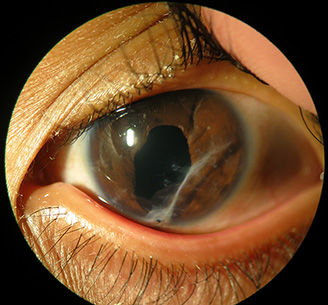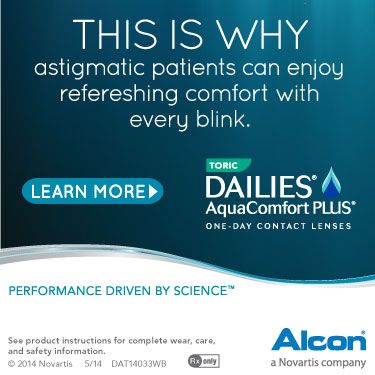

Last week, we had another very successful Global Specialty Lens Symposium (GSLS) in Las Vegas, NV. Our registrant attendance was at an all-time high with nearly 600 contact lens practitioners. The content of the presentations were stellar, and covered the gamut of everything and anything contact lens. We would like to also thank all of the sponsors of the meeting as we could not make this a success without you. If you have not been to GSLS before, I highly encourage you to next year.
|

|
In January Johnson & Johnson Vision Care announced it is closing its division in South Africa in early 2015, with sales and shipments of all Acuvue
products in South Africa to stop in the beginning of March. According to the company, this decision was made after a long and thoughtful review of its
business and after exploring a number of options in South Africa.
The company statement continues, “Johnson & Johnson Vision Care understands this news is very disappointing for both eye care professionals and contact
lens wearers, and is working closely with customers to ensure minimal disruption during this transition.”
|
|
Contamac Ltd. and Ocular Dynamics, whose mission is to create technologies which improve comfort for contact lens patients who experience dryness during
lens wear, announced a multi-year licensing, sub-licensable, manufacturing and commercialization agreement for incorporating the Hydra-PEG Technology into
Contamac’s Definitive 50 and Definitive 65 silicone hydrogel materials. The companies are also discussing an agreement for incorporating the Hydra-PEG
Technology into Contamac’s line of Optimum GP materials.
Under the new agreement, Contamac will begin the world-wide commercialization of incorporating the Hydra-PEG technology into specialty contact lenses that
are manufactured in Definitive silicone hydrogel materials, through sub-licensing the technology to the entire Contamac Ltd. global laboratory network
channel, commencing May 2015.
The Hydra-PEG technology is a permanently bonded Polyethylene Glycol (PEG) surface coating that augments contact lens wettability, lubricity, Tear Film
Surface Quality, and the lens’ ability to resist protein/lipid depositions. For GP lens wearers, whether corneal, large diameter or scleral, the patient
will enjoy a substantial reduction in the adaptation period, and both silicone hydrogel and GP lens wearers will experience improved initial, midday and
end-of-day comfort, according to the companies.
|
|
SynergEyes, Inc. has announced a new marketing campaign: “Transform”. The campaign centers on SynergEyes contact lenses and how they can transform a
patient’s vision while transforming an Independent eye care practitioner’s practice as well.
The new “Transform” campaign illustrates the unique and life-changing benefits of SynergEyes advanced technology contact lenses for both Independent ECPs
and their patients, supporting the SynergEyes goal of delivering solutions for astigmatism, presbyopia and irregular corneas. The dramatic, eye catching
and aspirational ads highlight the following message: “Transform your contact lens patients’ vision. Transform your practice with SynergEyes contact
lenses.” Under the SynergEyes umbrella, individual product lines also leverage the compelling campaign.
The “Transform” campaign was created by DevicePharm, an Irvine, California marketing strategy and integrated marketing solutions firm for organizations
serving medical professionals and healthcare consumers. The campaign launched in January 2015 with ads in optometric industry publications such as Optometric Management, as well as at the GSLS in Las Vegas.
|
|
The Association of Schools and Colleges of Optometry’s (ASCO) long term Executive Director, Marty Wall, MPA, CAE, is retiring in mid July 2015. For nearly
25 years, Wall has seen ASCO and optometric education go through tremendous growth and change.
As the Executive Director, Marty served as the chief staff executive of ASCO and, under the general direction and supervision of the Board of Directors,
was responsible for all elements of its operation. He administered and carried out programs and policies as well as assured attainment of the Association’s
strategic objectives and services to members. Through his effective management and leadership, he helped position the Association as the profession’s
academic leadership organization while achieving financial growth and advancing optometric education through the staff and volunteer structure.
|
|
NovaBay Pharmaceuticals, Inc. is expanding its sales force for its Avenova product for daily lid hygiene from 15 sales representatives to 35
representatives. Focusing on the eye care market and growing revenues are key aspects of the company’s recently unveiled business strategy, and, according
to the company, they plan to further increase the sales force to more than 50 representatives by July.
Each member of NovaBay’s sales team has at least 10 years of experience in ophthalmology and optometry. The team is led by NovaBay Vice President of Sales
and Marketing Glenn Moro, who has 27 years of experience marketing eye care products for Alcon Laboratories.
|

|
|

|

This is a 10 year-old patient with a history of a knife wound OS leading to a ruptured globe, irregular cornea, and aphakia. Vision is now 20/20 with a
large-diameter GP lens.
We thank Dr. Gates for this image and we welcome photo submissions from our other readers! It is easy to submit a photo for consideration for publishing in Contact Lenses Today. Simply visit http://www.cltoday.com/upload/upload.aspx to upload
your image. Please include an explanation of the photo and your full name, degree or title and city/state/country.
^ Back to top
|

|
Checking for Complete Lid Closure
One of my dry eye gurus is Robert Latkany, MD. In 2006 I read a monograph he penned regarding nocturnal lagophthalmos.1 Since then, I always
check for complete, unforced lid closure at the slit lamp. How I do it: First, as usual, I instill fluorescein. Then, with the cobalt blue-filtered light
on, I look at the patient’s closed eyelids from below as they are still positioned at the biomicroscope. Any green glow visible suggests to me that I best
investigate incomplete lid closure (during the day or night).
Blackie and Korb have recently published another way to check for lid closure, or “lid seal”.2 The Korb-Blackie Light test looks for light that
emanates from what appears to be closed lids. To perform this clinical test, a transilluminator is placed against the outer upper eyelids of relaxed,
closed lids. Then, look for light emanating from the lid area between the lashes.
The authors suggest that light emanating from between “closed” lids is associated with ocular discomfort upon awakening likely linked to the inability of
the lids to achieve an adequate seal to prevent subtle ocular surface desiccation during sleeping.
1. Latkany RL, Lock B, Speaker M. Nocturnal lagophthalmos: an overview and classification. Ocul Surf. 2006 Jan;4(1):44-53.
2. Blackie CA, Korb DR. A Novel Lid Seal Evaluation: The Korb-Blackie Light Test. Eye Contact Lens. 2014 Dec 10. [Epub ahead of print]
^ Back to top
|
|

|

|
RESEARCH REVIEW
S. Barry Eiden, OD, FAAO
|

|

|

|

|
|
Optical Placement in Multifocal Contact Lenses – Center Is Not Necessarily Better
I just returned from speaking at this year’s Global Specialty Lens Symposium in Las Vegas. I thought this would be a wonderful time to dedicate this week’s
column to a poster from GSLS.
The poster was created by my dear friend and contact lens expert, Mile Brujic, OD, FAAO, entitled How Important is Optical Placement in Multifocal Lenses?
The poster defined the angle lambda (or angle kappa) as the angle between the pupillary axis and the visual axis. Significant individual variability exists
in this angle due to variable anatomical relationships between the fovea, lens, pupil and cornea. The result is that most often the line of sight does not
run through the center of the pupil, but is typically decentered nasally. Since a well fit soft multifocal lens will center over the cornea and often place
the center of the optics over the center of the pupil there is a discrepancy between the line of sight and the center of the contact lens optics. This can
result in sub-optimal optical performance of the multifocal contact lens.
Measurement of the distance between the visual axis and the pupillary axis as it intersects the corneal plane can be performed with many contemporary
topography systems. In addition, contact lens designs that incorporate anterior surface multifocal optics can be mapped with topography while on the eye to
demonstrate the positioning of the central optics in relation to the visual axis. By utilizing this diagnostic imaging technique we can measure the
decentration of the optics of the multifocal lens on the eye.
Dr. Brujic further describes in his poster how a novel soft multifocal lens design that can be fabricated with custom decentration of the optics can
address poor near vision performance of a near centered soft multifocal contact lens. Visual acuity in his case report improved from 20/40 with centered
optics to 20/25 with decentered optics with no degradation in distance vision. All other parameters of the lens remained the same between the centered and
decentered optics lenses.
Although today we have a multitude of excellent “stock” design multifocal soft contact lenses that have the advantage of frequent replacement, and relative
affordability, there are many times where stock lenses simply do not provide the quality of vision required by our patients. Many of these cases may be
associated with large angle lambda and could benefit from the use of custom multifocal designs that can provide decentered optics as well as far more
extensive control of power and fitting parameters than is available in stock disposable multifocal soft lenses.
Brujic M. How Important Is Optical Placement in Multifocal Lenses? Poster presented at the 2015 Global Specialty Lens Symposium. Las Vegas, NV. Jan 2015.
^ Back to top
|

|

|
|
Autologous Serum Eye Drops for the Treatment of Ocular Surface Disease
|
|
The objective of this study was to examine the evidence for the role of autologous serum eye drops (ASD) in disease of the ocular surface.
A search of the literature published through May 2014 using PubMed, the ISI Web of Knowledge database, and the Cochrane Library was performed. Qualified
articles were selected after review of titles, abstracts, and references.
There was a significant improvement in either symptoms or some of the clinical examination findings, including tear breakup time, corneal staining,
Schirmer values, and impression cytology in eyes with persistent corneal epithelial defect, graft-versus-host disease, Sjögren- and non-Sjögren-related dry
eye disease, limbal stem-cell deficiency, recurrent corneal erosion, superior limbic keratoconjunctivitis, and post refractive surgery. However, most of
the studies were nonrandomized in nature.
The authors concluded that, despite the paucity of strong supporting evidence from randomized double-masked clinical studies, there seems to be a trend
toward superiority of ASD in alleviating some of the clinical signs and symptoms associated with corneal pathology in a variety of conditions that affect
the ocular surface compared with conventional lubricating drops/ointments.
Azari AA, Rapuano CJ. Autologous Serum Eye Drops for the Treatment of Ocular Surface Disease. Eye Contact Lens. 2015 Jan 19. [Epub ahead of print]
|
|
|

|
|
A Proud Supporter of

Important Links:
To report adverse contact lens reactions visit:
http://www.accessdata.fda.gov/scripts/medwatch/ or call (800) FDA-1088.
To report possible grievances related to the Fairness to Contact Lens Consumers
Act or associated Contact Lens Rule visit:
https://www.ftccomplaintassistant.gov/.
CLToday Services:
Subscribe;
Unsubscribe; Submit Clinical
Image
Submit news to cltoday@pentavisionmedia.com.
Send your comments and fitting tips to
cltoday@pentavisionmedia.com. Please include your full name, degree or title
and city/state/country.
For more information on Contact Lenses Today including archives of previous
issues, please visit our website at www.cltoday.com.
For the latest articles on contact lenses, important clinical information and helpful
tools related to the contact lens practice visit the Contact Lens Spectrum
website at www.clspectrum.com.
© 2015 All Rights Reserved Contact Lenses Today and CLToday
are registered trademarks of:
PentaVision LLC, 321 Norristown Road, Suite 150, Ambler, PA 19002 | 215-646-8700
© 2015 PentaVision LLC All Rights Reserved.
|

|
|
|



















